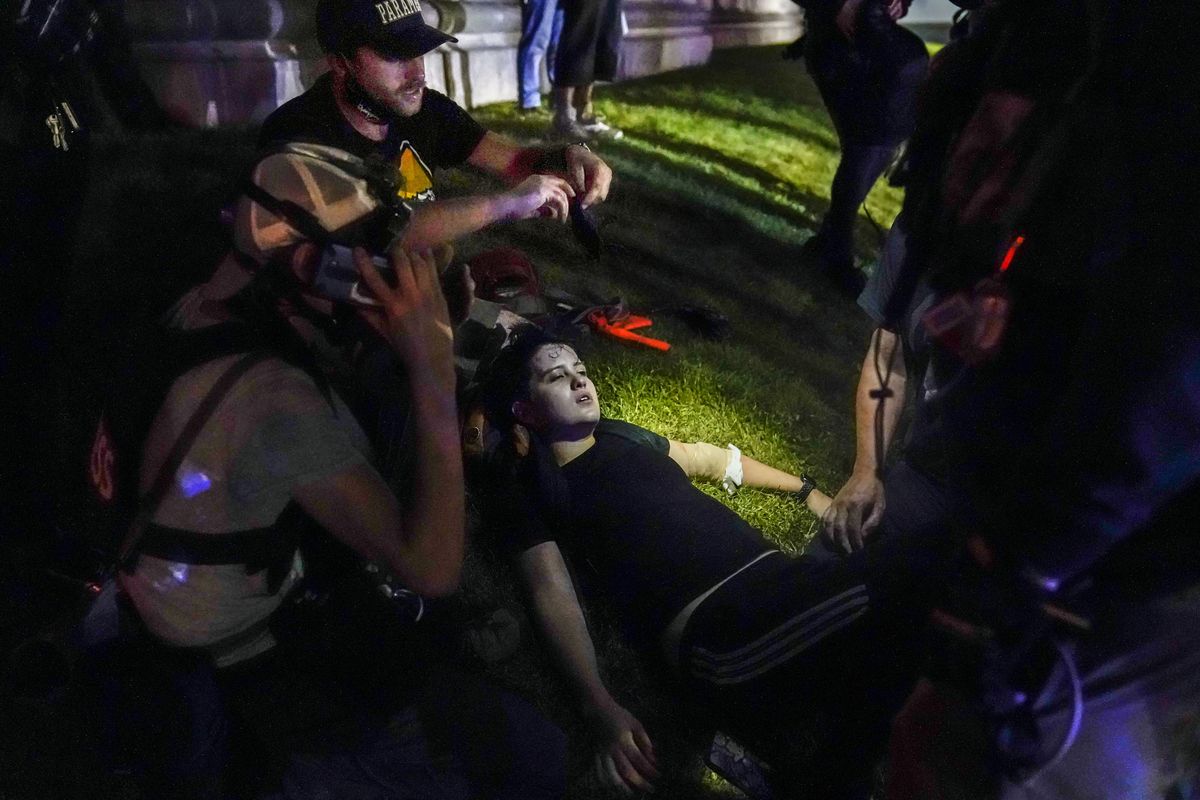Rittenhouse shooting victim: Thought ‘I was going to die’

KENOSHA, Wis. – A witness at Kyle Rittenhouse’s murder trial testified Monday that he confronted a rifle-toting Rittenhouse with a gun of his own to try to stop the bloodshed, and thought he was going to die as he closed in on the young man.
Gaige Grosskreutz, who said he had gone to the racial-justice protest in the streets of Kenosha that night to serve as a volunteer medic, ended up getting shot and seriously wounded in the arm by Rittenhouse.
Grosskreutz, 27, went into action after seeing Rittenhouse kill a man just feet away – the second person Rittenhouse fatally shot that night.
“I thought the defendant was an active shooter,” Grosskreutz said, recounting how he pulled out the pistol he had holstered.
Asked what was going through his mind as he neared the 17-year-old Rittenhouse, he said, “That I was going to die.”
On cross-examination, defense attorney Corey Chirafisi sought to portray Grosskreutz as dishonest in his description of the moments right before he was shot, with Chirafisi asserting that Grosskreutz was chasing Rittenhouse with his gun out.
Grosskreutz said he was not chasing Rittenhouse.
Chirafisi also pointed to Grosskreutz’s lawsuit against the city of Kenosha, in which he alleges police enabled the violence by allowing an armed militia to have the run of the streets during the demonstration.
“If Mr. Rittenhouse is convicted, your chance of getting 10 million bucks is better, right?” Chirafisi said.
Rittenhouse, now 18, is on trial on charges of killing two men and wounding Grosskreutz during the turbulent protest in the summer of 2020.
The one-time police youth cadet from Antioch, Illinois, had gone to Kenosha with an AR-style semi-automatic rifle and a medical kit in what he said was an effort to safeguard property from the damaging demonstrations that broke out over the shooting of Jacob Blake, a Black man, by a white Kenosha police officer.
Grosskreutz had a gun in has hand, with his arms raised, when Rittenhouse fired, shooting him in the bicep. Prosecutor Thomas Binger asked Grosskreutz, who had his hands in the air just before Rittenhouse shot him, why he didn’t shoot first.
“That’s not the kind of person that I am. That’s not why I was out there,” he said. “It’s not who I am. And definitely not somebody I would want to become.”
When the prosecutor played graphic video of Grosskreutz’s badly wounded arm, with much of his bicep torn away by the bullet, a few jurors seemed to grimace and look away from monitors in the courtroom.
Grosskreutz said he was wearing a hat that night that said “paramedic” and was carrying medical supplies, in addition to a loaded pistol. Grosskreutz said his permit to carry a concealed weapon had expired and he did not have a valid permit that night.
“I believe in the Second Amendment. I’m for people’s right to carry and bear arms,” he said, explaining why he was armed. “And that night was no different than any other day. It’s keys, phone, wallet, gun.”
At the defense table, Rittenhouse kept his eyes on Grosskreutz as he testified, taking detailed notes when the witness spoke about the moment he was shot.
Earlier that night, Grosskreutz was recording on his cellphone for a livestream when he heard gunshots a few blocks away. He heard people yelling for a medic, and ran toward the sound of the gunfire.
The video played in court showed Grosskreutz coming upon Rittenhouse as Rittenhouse was running away. He asked him what Rittenhouse was doing and if someone was shot. Rittenhouse replied: “I’m going to the police. I didn’t do anything.” At the time, Grosskreutz testified, he thought Rittenhouse said, “I’m working with the police.”
Grosskreutz ran along with Rittenhouse for a few seconds, then turned to go help whoever might have been shot. But then Grosskreutz turned back toward Rittenhouse because he heard people saying Rittenhouse had shot someone.
One juror nodded her head in agreement when the judge instructed the jury to disregard Grosskreutz’s referring to Rittenhouse’s fatal shooting of another protester as a “murder.“
Grosskreutz, who was trained as a paramedic, testified that he volunteered as a medic at protests in Milwaukee in the days after George Floyd died under the knee of a Minneapolis police officer in May 2020. Grosskreutz said he attended around 75 protests before the night he was shot, offering help to anyone needing medical attention.
He said he provided medical assistance to about 10 other people that night in Kenosha.
Rittenhouse is white, as are the men he shot, but the case has stirred furious debate about racial justice, policing, vigilantism and the right to bear arms.
Prosecutors have portrayed Rittenhouse as the instigator of the bloodshed. Rittenhouse’s lawyer has argued that he acted in self-defense, suggesting among other things that Rittenhouse feared his weapon would be taken and used against him.
In the first week of Rittenhouse’s trial, witnesses testified that the first man shot and killed, Joseph Rosenbaum, 36, was “hyperaggressive” and “acting belligerently” that night and threatened to kill Rittenhouse at one point.
One witness said Rosenbaum was gunned down after he chased Rittenhouse and lunged for the young man’s rifle.
Rosenbaum’s killing set in motion the bloodshed that followed moments later: Rittenhouse shot and killed Anthony Huber, a 26-year-old protester seen on bystander video hitting Rittenhouse with a skateboard. Rittenhouse then wounded Grosskreutz.
Rittenhouse could get life in prison if convicted.
Grosskreutz has a tattoo on the arm where he was shot. It is the common medical image of a snake wrapped around a staff, and at the top it has a banner that says, “Do no harm” and at the bottom, a banner reading “Do know harm.”
Grosskreutz testified that he has difficulty lifting heavy objects with his right arm and has a loss of feeling extending from his bicep to his thumb.